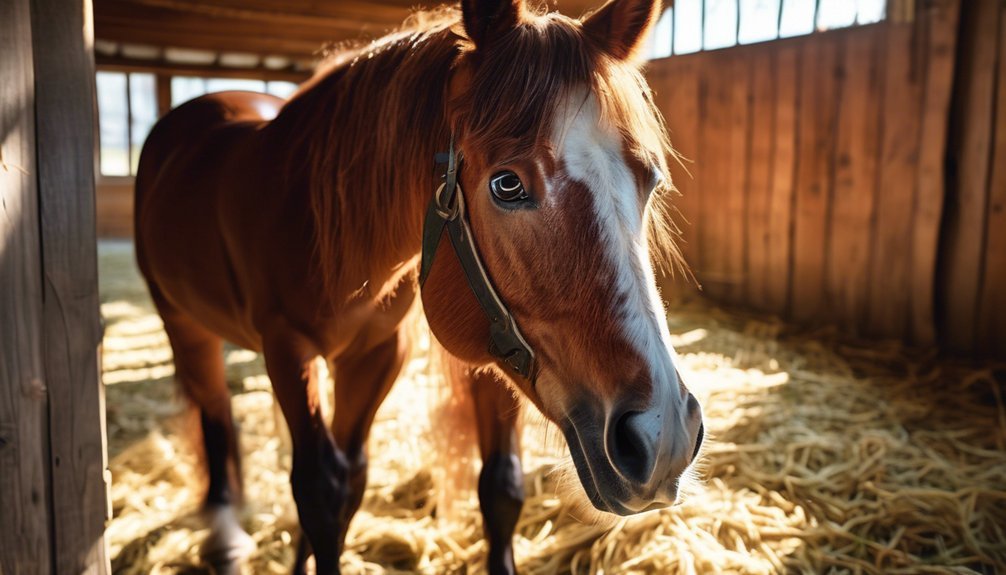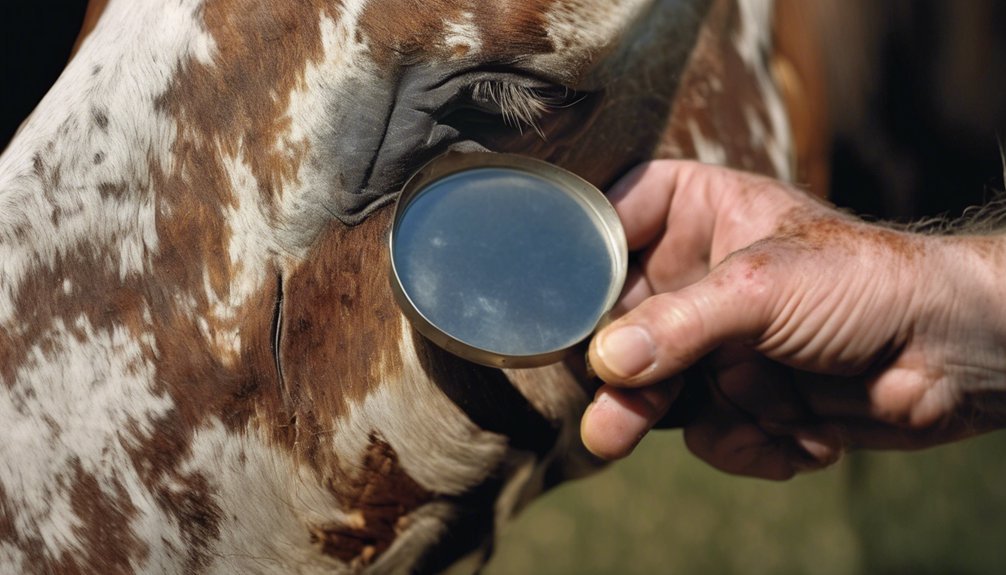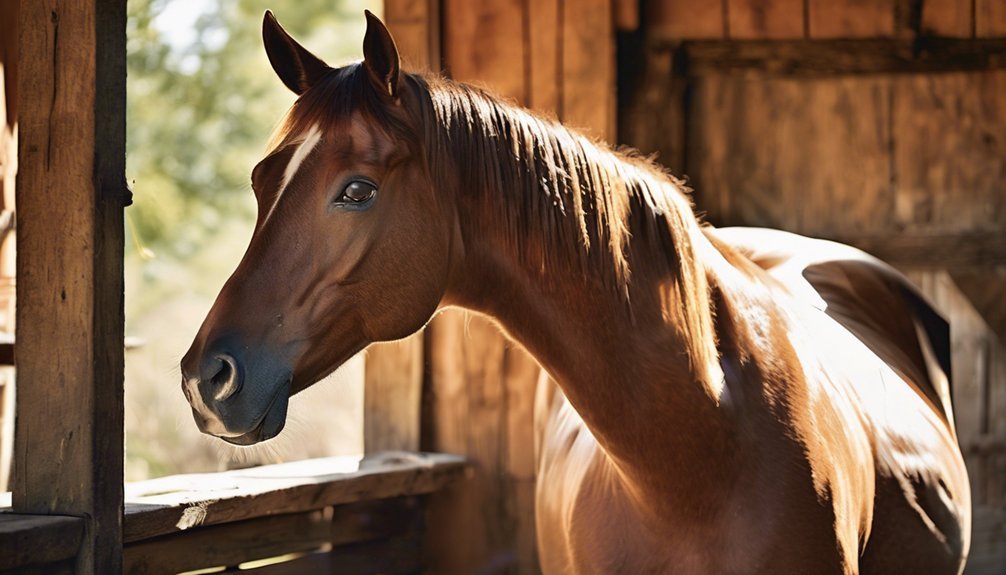
You might think fungal infections in horses are rare, but they can actually affect any horse at any time. Recognizing the signs early is crucial for effective treatment and recovery. By understanding the types of infections and their symptoms, you can take proactive steps to protect your horse's health. The journey begins with awareness, and knowing what to look for can make all the difference. What steps can you take to ensure your horse stays healthy?
Key Takeaways
- Identify early signs of fungal infections, such as itching and patchy hair loss, for timely intervention and treatment.
- Maintain a clean and dry living environment to reduce humidity and prevent fungal growth.
- Use topical antifungal treatments as directed by a veterinarian for effective management of skin infections.
- Regularly groom your horse to remove moisture and debris that can contribute to fungal infections.
- Strengthen your horse's immune system with a balanced diet and avoid stressful conditions to enhance overall health.
Understanding Fungal Infections in Horses

When you consider the health of your horse, understanding fungal infections is crucial, as these conditions can significantly impact their coat and overall well-being.
Fungal life cycles often begin when spores land on your horse's skin, especially in warm, damp environments. Your horse's immune response plays a vital role in combating these infections; a strong immune system can help prevent the establishment of harmful fungi.
However, factors like stress, poor nutrition, or environmental conditions can weaken this defense. Recognizing early signs, such as itching or coat changes, allows you to take prompt action.
Common Types of Fungal Infections
Understanding the common types of fungal infections that can affect your horse's coat is essential for effective prevention and treatment.
One prevalent issue is the ringworm infection, caused by dermatophytes, which manifests as circular patches of hair loss and scabs. It's highly contagious, so catching it early is crucial to prevent spread among your horses.
Another concern is yeast infection, often linked to moisture and poor hygiene. This can lead to inflammation and discomfort in areas like the mane and tail.
By familiarizing yourself with these infections, you can take proactive measures to maintain your horse's health and comfort.
Always consult your veterinarian for a tailored approach to diagnosis and treatment, ensuring your equine companion stays happy and healthy.
Symptoms to Look Out For

Recognizing the symptoms of fungal infections in your horse's coat is vital for prompt treatment and recovery.
Early symptom identification can prevent further complications. Here are some key signs to watch for:
- Hair loss: Patches of missing fur can indicate coat abnormalities.
- Itching or irritation: If your horse is scratching or biting at its coat, it could be a sign of discomfort.
- Red or inflamed skin: Look for areas of redness, which may signal an underlying infection.
- Scales or crusts: The presence of flaky skin or crusty patches often accompanies fungal infections.
Staying vigilant about these symptoms will help you address any issues early, ensuring your horse remains healthy and comfortable.
Causes of Fungal Infections
Fungal infections in your horse's coat can arise from several factors, often linked to environmental conditions and management practices. High humidity, poor ventilation, and damp bedding create an ideal breeding ground for fungi.
If your horse's immune response is compromised due to stress, illness, or poor nutrition, it's more susceptible to these infections. Additionally, close contact with other infected horses can increase the risk.
Regular grooming and maintaining a clean living environment can significantly reduce these risks. By understanding these causes, you can take proactive steps to protect your beloved companion.
Keeping an eye on your horse's overall health and ensuring a balanced diet will help boost their immune response, making them less vulnerable to fungal infections.
Diagnosing Fungal Infections

Identifying fungal infections in your horse's coat requires careful observation and attention to specific signs.
You'll want to look for:
- Bald patches: Noticeable areas where hair is missing, often with scaly skin.
- Itching or irritation: Your horse may scratch or bite at affected areas.
- Discoloration: Look for changes in coat color, such as redness or dullness.
- Odor: An unpleasant smell can indicate fungal growth.
Once you've observed these signs, it's wise to consult your veterinarian.
They may recommend diagnostic tests and fungal cultures to confirm the presence of a fungal infection.
Early detection is crucial for effective management, so trust your instincts and seek help when needed.
Your horse's health depends on it.
Treatment Options for Infected Horses
Effective treatment options for horses suffering from coat fungal infections can significantly improve their health and comfort.
Start with topical antifungals, which directly target the infection on the skin. You might also need to consider oral medications for more severe cases, providing systemic support.
Remember, improving horse hygiene is crucial; regularly groom and bathe your horse with antifungal shampoos to help eliminate spores.
Environmental management plays a vital role too—ensure your horse's living area is clean and dry, reducing moisture that fosters fungal growth.
By combining these approaches, you not only treat the infection effectively but also enhance your horse's overall well-being.
Your commitment to their health will shine through in their recovery and comfort.
Home Remedies and Natural Treatments

When your horse develops a coat fungal infection, exploring home remedies and natural treatments can be a valuable part of the healing process.
Here are some effective options you might consider:
- Tea Tree Oil: This powerful essential oil has antifungal properties. Dilute it with a carrier oil and apply it topically to the affected areas.
- Apple Cider Vinegar: Its acidic nature can help restore skin pH. Mix equal parts with water and spray it on the infected spots.
- Coconut Oil: Known for its moisturizing and antifungal effects, apply it directly to soothe and heal the skin.
- Aloe Vera Gel: This soothing herbal solution can help reduce inflammation and promote healing when applied topically.
These natural treatments can support your horse's recovery and restore their coat's health.
Preventative Measures for Horse Owners
Maintaining your horse's health goes beyond treating fungal infections; it also involves implementing preventative measures to reduce the risk of recurrence.
Start by establishing rigorous cleaning protocols in your barn. Regularly disinfect stalls, water buckets, and grooming tools to minimize fungal spores.
Ensure proper stable hygiene by removing manure and wet bedding promptly, as damp conditions promote fungal growth. Additionally, provide adequate ventilation in the stable to keep the environment dry and airy.
When your horse is out in the pasture, avoid overcrowding, which can increase stress and susceptibility to infections.
Importance of Regular Grooming

Regular grooming plays a crucial role in your horse's overall health and well-being, as it not only keeps their coat clean but also allows you to spot potential issues early.
By incorporating effective grooming techniques, you can significantly enhance your horse's coat health. Here are four key benefits of regular grooming:
- Dirt and Debris Removal: Regular brushing helps eliminate dirt and loose hair, preventing skin irritations.
- Circulation Boost: Grooming stimulates blood flow, promoting a healthy coat and skin.
- Early Detection: You can identify lumps, bumps, or fungal infections before they escalate.
- Bonding Time: Grooming fosters a deeper connection between you and your horse, enhancing trust and comfort.
Commit to a consistent grooming routine, and you'll support your horse's health and happiness.
When to Consult a Veterinarian
Grooming your horse is an excellent way to keep an eye on their health, but some situations require professional attention. If you notice persistent patches of hair loss, redness, or unusual odor, it's crucial to know when to seek veterinary help.
Look for signs of urgency, such as excessive itching, swelling, or if the condition worsens despite your efforts. Fungal infections can spread quickly and lead to more severe complications if left untreated.
Trust your instincts; if something feels off, don't hesitate to call your veterinarian. They can provide a proper diagnosis and recommend an effective treatment plan.
Your horse's comfort and well-being depend on timely intervention, so stay vigilant and proactive in their care.
Frequently Asked Questions
Can Horses Develop Allergies to Fungal Infections?
Yes, horses can develop allergies to fungal infections. You might notice allergy symptoms like itching or swelling, indicating an immune response. Monitoring your horse's skin health is vital for early detection and effective management.
Are Certain Breeds More Susceptible to Fungal Infections?
Like a fingerprint, each horse's breed reveals unique genetic factors influencing susceptibility to fungal infections. While some breeds may be more prone, individual care and environment also play crucial roles in their overall health and resilience.
How Long Does Treatment Typically Take?
Treatment duration generally ranges from a few weeks to several months, depending on the severity of the infection. You'll notice improvements within the recovery timeline, but staying consistent with care is crucial for full healing.
Can Fungal Infections Spread to Other Animals?
Oh sure, let's throw a fungal party! But seriously, yes, fungal transmission can spread to other animals. It's vital to monitor animal health and prevent cross-contamination. Keeping a close eye ensures everyone stays healthy and happy.
What Is the Cost of Treating Fungal Infections in Horses?
Treating fungal infections in horses can vary in cost depending on treatment options and prevention strategies. You might spend anywhere from $50 to several hundred dollars, depending on severity and necessary veterinary care.
Conclusion
In conclusion, staying vigilant against horse coat fungal infections is essential for your horse's health. By recognizing symptoms early and implementing effective treatments, you can prevent these pesky invaders from taking root. Think of your horse's coat as a protective shield; with regular grooming and proper nutrition, you can fortify it against future threats. Don't hesitate to consult a veterinarian if you notice concerning signs—your horse's well-being depends on your proactive care.





